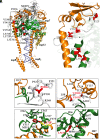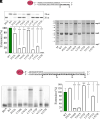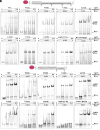Point mutations at specific sites of the nsp12-nsp8 interface dramatically affect the RNA polymerization activity of SARS-CoV-2
- PMID: 38990941
- PMCID: PMC11260105
- DOI: 10.1073/pnas.2317977121
Point mutations at specific sites of the nsp12-nsp8 interface dramatically affect the RNA polymerization activity of SARS-CoV-2
Abstract
In a recent characterization of the Severe Acute Respiratory Syndrome Coronavirus 2 (SARS-CoV-2) variability present in 30 diagnostic samples from patients of the first COVID-19 pandemic wave, 41 amino acid substitutions were documented in the RNA-dependent RNA polymerase (RdRp) nsp12. Eight substitutions were selected in this work to determine whether they had an impact on the RdRp activity of the SARS-CoV-2 nsp12-nsp8-nsp7 replication complex. Three of these substitutions were found around the polymerase central cavity, in the template entry channel (D499G and M668V), and within the motif B (V560A), and they showed polymerization rates similar to the wild type RdRp. The remaining five mutations (P323L, L372F, L372P, V373A, and L527H) were placed near the nsp12-nsp8F contact surface; residues L372, V373, and L527 participated in a large hydrophobic cluster involving contacts between two helices in the nsp12 fingers and the long α-helix of nsp8F. The presence of any of these five amino acid substitutions resulted in important alterations in the RNA polymerization activity. Comparative primer elongation assays showed different behavior depending on the hydrophobicity of their side chains. The substitution of L by the bulkier F side chain at position 372 slightly promoted RdRp activity. However, this activity was dramatically reduced with the L372P, and L527H mutations, and to a lesser extent with V373A, all of which weaken the hydrophobic interactions within the cluster. Additional mutations, specifically designed to disrupt the nsp12-nsp8F interactions (nsp12-V330S, nsp12-V341S, and nsp8-R111A/D112A), also resulted in an impaired RdRp activity, further illustrating the importance of this contact interface in the regulation of RNA synthesis.
Keywords: RNA synthesis; RNA-dependent RNA polymerase; nsp12–nsp8–nsp7 complex; primer extension; protein–protein interactions.
Conflict of interest statement
Competing interests statement:The authors declare no competing interest.
Figures




Similar articles
-
Biochemical characterization of naturally occurring mutations in SARS-CoV-2 RNA-dependent RNA polymerase.Protein Sci. 2024 Sep;33(9):e5103. doi: 10.1002/pro.5103. Protein Sci. 2024. PMID: 39145418 Free PMC article.
-
Biochemical simulation of mutation synthesis and repair during SARS-CoV-2 RNA polymerization.Virology. 2024 Dec;600:110255. doi: 10.1016/j.virol.2024.110255. Epub 2024 Oct 1. Virology. 2024. PMID: 39366027
-
Mutations in SARS-CoV-2 nsp7 and nsp8 proteins and their predicted impact on replication/transcription complex structure.J Med Virol. 2021 Jul;93(7):4616-4619. doi: 10.1002/jmv.26791. Epub 2021 Mar 14. J Med Virol. 2021. PMID: 33433004 Free PMC article.
-
Fast and efficient purification of SARS-CoV-2 RNA dependent RNA polymerase complex expressed in Escherichia coli.PLoS One. 2021 Apr 29;16(4):e0250610. doi: 10.1371/journal.pone.0250610. eCollection 2021. PLoS One. 2021. PMID: 33914787 Free PMC article.
-
Replication of the coronavirus genome: A paradox among positive-strand RNA viruses.J Biol Chem. 2022 May;298(5):101923. doi: 10.1016/j.jbc.2022.101923. Epub 2022 Apr 10. J Biol Chem. 2022. PMID: 35413290 Free PMC article. Review.
Cited by
-
A post-assembly conformational change makes the SARS-CoV-2 polymerase elongation-competent.bioRxiv [Preprint]. 2025 Jan 10:2025.01.10.632299. doi: 10.1101/2025.01.10.632299. bioRxiv. 2025. Update in: Nucleic Acids Res. 2025 May 22;53(10):gkaf450. doi: 10.1093/nar/gkaf450. PMID: 39829827 Free PMC article. Updated. Preprint.
-
Incipient functional SARS-CoV-2 diversification identified through neural network haplotype maps.Proc Natl Acad Sci U S A. 2024 Mar 5;121(10):e2317851121. doi: 10.1073/pnas.2317851121. Epub 2024 Feb 28. Proc Natl Acad Sci U S A. 2024. PMID: 38416684 Free PMC article.
-
A post-assembly conformational change makes the SARS-CoV-2 polymerase elongation-competent.Nucleic Acids Res. 2025 May 22;53(10):gkaf450. doi: 10.1093/nar/gkaf450. Nucleic Acids Res. 2025. PMID: 40464687 Free PMC article.
References
MeSH terms
Substances
Grants and funding
- PID2020-117976 GB-I00/Ministerio de Ciencia e Innovación (MCIN)
- PID2020-113888RB-I00/Ministerio de Ciencia e Innovación (MCIN)
- 202220I116/Ministerio de Ciencia e Innovación (MCIN)
- PI21/00139/MEC | Instituto de Salud Carlos III (ISCIII)
- CSIC-COV19-014/MEC | Consejo Superior de Investigaciones Científicas (CSIC)
LinkOut - more resources
Full Text Sources
Research Materials
Miscellaneous

